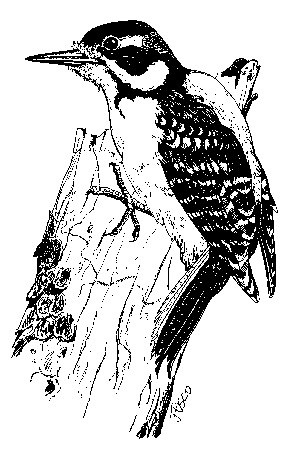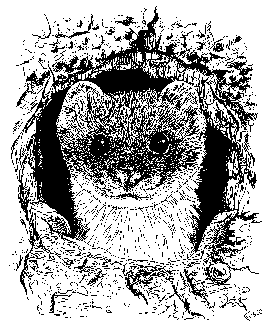Snags for Wildlife
What Is a Snag?
A snag is any dead or dying standing tree. For wildlife purposes, snags should be at least three inches in diameter at breast height (dbh) and at least six feet tall.
Snags may develop cavities which either occur naturally or are excavated by birds and mammals.
Why Snag Management?
Over 85 species of North American birds, 35 of which occur in the Northeast, use cavities in dead or deteriorating trees. Snags also provide essential habitat requirements for cavity-using amphibians, reptiles and mammals. Snags are used for nesting, shelter and feeding sites.
The removal of snags can negatively impact wildlife populations that are dependent on them as essential habitat components. Cavity nesters evolved in unmanaged forest stands where snags developed naturally. Snag and den trees are becoming short in supply as forests are being intensively managed, whether through cordwood cutting, timber management or land clearing. These activities tend to accelerate the removal of existing snags and diminish the probability of trees ever becoming large enough to serve as possible snag or den trees.
One Very Important Benefit
Insectivorous birds such as woodpeckers and nuthatches depend heavily on snags as a source of food. These birds, in addition to being an integral part of our natural ecosystem, are very beneficial in helping to control unwanted insect pests. The importance and benefits derived from insectivorous birds as biological control agents are receiving more attention.
How Many Snags?
Each forest community has different requirements in terms of the number, species and size of snags necessary to support all the cavity users associated with that community.
The number and size of available snags affects not only the presence or absence of snag-dependent wildlife but also wildlife population levels. Generally, the value of a snag tree increases as its size increases. To assure that the minimum requirements of most wildlife species are being met, three snags of 12 inches dbh or greater should be available per acre. All snags should remain in clearcuts, in wildlife openings and within 100 feet of wetland or riparian areas. Since cavity-nesting birds such as woodpeckers usually have large territories, snags should be well distributed.
A minimum of one 15-inch dbh or greater diameter den tree should also remain per acre. Den trees are trees that are living or partially living and possess a cavity large enough to serve as shelter or as a site for birds and mammals to give birth and raise young. In time, they will also serve as future snag trees.
Management Recommendations
Landowners and land managers who have forested land that does not meet the minimum acceptable levels of snag and den trees can follow the recommendations listed below:
- Girdle trees (preferably cull trees).
- Provide artificial nest cavities (nest boxes).
- Set aside a percentage of the acreage to remain unmanaged (managed naturally).
- Bore holes in suitable-sized trees where cavity availability is limited.
- Consider leaving permanent uncut buffer strips on both sides of streams.
- Discontinue removal of dead, dying and decayed trees for use as firewood in areas where nest cavity sites are limited.
Glossary
Buffer strip -- a strip of vegetation that is left or managed to reduce the impact of a treatment or action of one area on another.
Cull -- trees, logs, or lumber which have been rejected because they do not meet certain specifications.
Den tree -- a tree having the trunk or large limbs hollowed out by rotting, with an opening to the outside. This includes some snags, but den trees are usually alive and often produce mast (dry fruit).
Diameter at breast height (dbh) -- the standard diameter measurement for standing trees, including bark, taken at four and one-half feet above ground.
Insectivorous -- feeding on insects.
Riparian -- an area identified by the presence of vegetation that requires free or unbound water or conditions more moist than normally found in the area.
Rotation age -- the age of the forest stand when the final harvest cut is made.
 The Technical Assistance
Informational Series is 75 percent funded by Federal Aid to Wildlife Restoration -
Pittman-Robertson (P-R) Program. The P-R Program provides funding through an excise tax on
the sale of sporting firearms, ammunition, and archery equipment. The remaining 25 percent
of the funding is matched by the Connecticut Wildlife Division. (rev. 12/99)
The Technical Assistance
Informational Series is 75 percent funded by Federal Aid to Wildlife Restoration -
Pittman-Robertson (P-R) Program. The P-R Program provides funding through an excise tax on
the sale of sporting firearms, ammunition, and archery equipment. The remaining 25 percent
of the funding is matched by the Connecticut Wildlife Division. (rev. 12/99)

